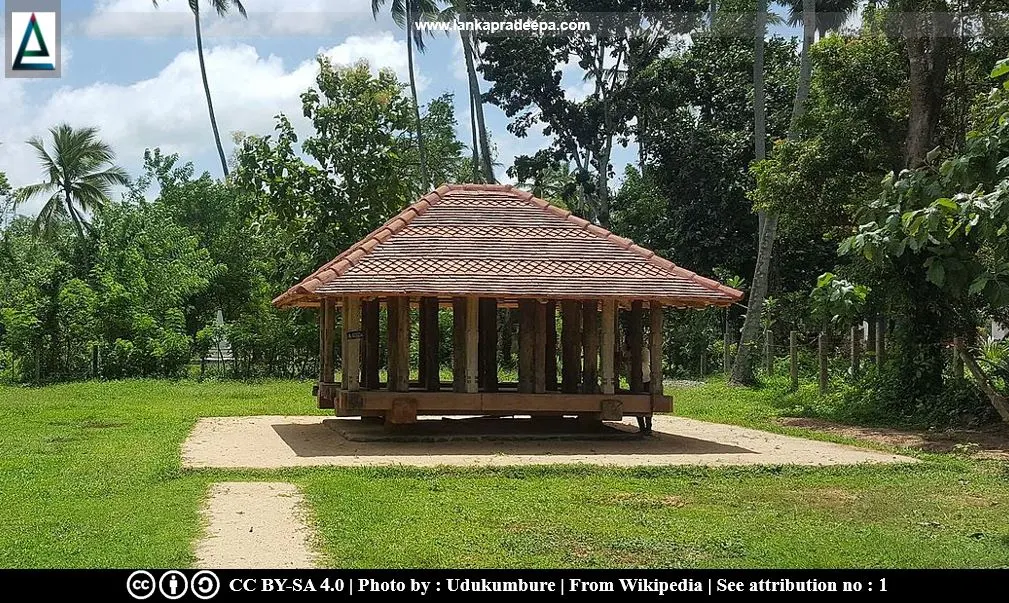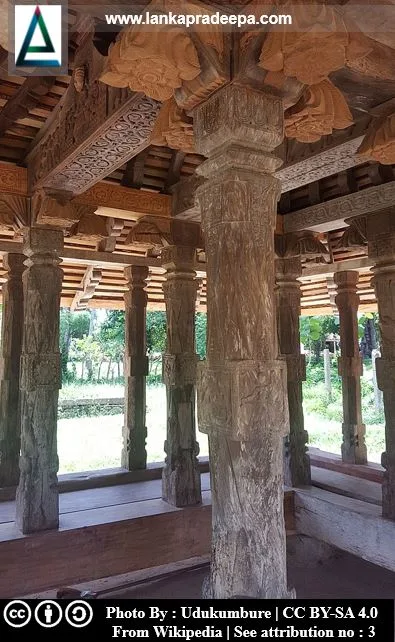
The Panavitiya Ambalama (Sinhala: පනාවිටිය අම්බලම; Tamil: பணாவிட்டிய அம்பலம) is an old wayside rest located in the village of Panavitiya in Kurunegala District, Sri Lanka. This Ambalama is considered special among other Ambalamas in the country because of its exquisite wood carvings found on the pillars and the beams of the roof.
Ambalama
Ambalamas are traditional resting places built by locals to accommodate
wayfarers who were travelling to distant places. They were also used as a
place for people to gather, hold meetings and serve as a public place
in society. During the 16th, 17th and 18th centuries, Ambalamas were
spread all over the country. The Ambalama at Panavitiya is one such structure, believed to have been erected in the 18th century (Anuradha & Kumari, 2015; Mendis et al., 2019). Situated on a flat land bordered by a paddy field, this Ambalama may have been built on an ancient footpath leading from Dambadeniya to Kurunegala and Yapahuwa (Godakumbure, 1993).
The structure
The Ambalama has been mounted on a platform raised about half a foot from the ground (Anuradha & Kumari, 2015). The platform, filled with stone pebbles and crushed rocks, is about 12 ft. 4 inches long and 9 ft. 6 inches wide (Godakumbure, 1993). The wooden framework has been constructed on four round boulders, placed at the four corners of the stone-filled platform. Four timber logs that are balanced on the four-round boulders, make the base of the wooden framework. The roof is supported by 28 wooden posts arranged in two sets. The outer set contains 19 posts and the inner set comprises 9 posts. The 9 inner posts are 6 ft. 2 inches high while the 19 outer posts are 5 ft. 8 inches high (Godakumbure, 1993). The capitals of each post have been decorated with Pekada carvings.
The roof which has been paved with flat clay tiles is 18 ft. 3 inches long and 16 ft. 6 inches wide (Godakumbure, 1993). The height from the stone-filled foundation to the ridge of the roof is 11 ft. 5 inches (Godakumbure, 1993).
Conservation
The Ambalama, according to the Archaeology Commissioner's Report for the years 1960-1961, was in a dilapidated state. At the time, most of the wooden framework had decayed and the roof was thatched with straw instead of its original clay tiles. Also, the roof had been damaged by a coconut tree falling on the structure (Godakumbure, 1993). During the period 1961-1962, the conservation works of the Ambalama were done by the Department of Archaeology under the direction of Charles Godakumbura, the then Commissioner of Archaeology. During the conservation, the roof which had been thatched with straw was replaced by tiles to regain the original appearance of the structure.
The Ambalama was conserved again later in 2016.
The carvings which are found carved on inner pillars, pillar heads, beams, rafters, and reapers, mainly depict the scenes of musicians, dancers, wrestlers, acrobats, animals, birds, etc (Anuradha & Kumari, 2015). The inner pillars which are octagon in shape have four-sided medial panels and each of them contains elaborate carvings. The themes of these carvings may depict the reality of the authentic rural society of the 18th century.
The roof which has been paved with flat clay tiles is 18 ft. 3 inches long and 16 ft. 6 inches wide (Godakumbure, 1993). The height from the stone-filled foundation to the ridge of the roof is 11 ft. 5 inches (Godakumbure, 1993).
Conservation
The Ambalama, according to the Archaeology Commissioner's Report for the years 1960-1961, was in a dilapidated state. At the time, most of the wooden framework had decayed and the roof was thatched with straw instead of its original clay tiles. Also, the roof had been damaged by a coconut tree falling on the structure (Godakumbure, 1993). During the period 1961-1962, the conservation works of the Ambalama were done by the Department of Archaeology under the direction of Charles Godakumbura, the then Commissioner of Archaeology. During the conservation, the roof which had been thatched with straw was replaced by tiles to regain the original appearance of the structure.
The Ambalama was conserved again later in 2016.
Wood Carvings
The Panavitiya Ambalama is widely famous for its exquisitely carved woodwork that may belong to the 18th century A.D. (Godakumbure, 1993).The carvings which are found carved on inner pillars, pillar heads, beams, rafters, and reapers, mainly depict the scenes of musicians, dancers, wrestlers, acrobats, animals, birds, etc (Anuradha & Kumari, 2015). The inner pillars which are octagon in shape have four-sided medial panels and each of them contains elaborate carvings. The themes of these carvings may depict the reality of the authentic rural society of the 18th century.




.
Attribution
1) පනාවිටිය අම්බලම (22) by Udukumbure is licensed under CC BY-SA 4.02) පනාවිටිය අම්බලම කැටයම් 02, පනාවිටිය අම්බලම කැටයම් 05, පනාවිටිය අම්බලම කැටයම් 08 by Udukumbure are licensed under CC BY-SA 4.0
3) පනාවිටිය අම්බලම කැටයම් 19 by Udukumbure is licensed under CC BY-SA 4.0
4) පනාවිටිය අම්බලම කැටයම් 03, පනාවිටිය අම්බලම කැටයම් 06, පනාවිටිය අම්බලම කැටයම් 20 by Udukumbure are licensed under CC BY-SA 4.0
5) පනාවිටිය අම්බලම කැටයම් 14 by Udukumbure is licensed under CC BY-SA 4.0
References
1) Anuradha, R.K.S.; Kumari, A.S., 2015. Pauranika Sthana Saha Smaraka:
Kurunegala Distrikkaya (In Sinhala). Department of Archaeology (Sri
Lanka). ISBN: 955-9159-37-2. pp.43-44.
2) Godakumbure, C.E., 1993. Rest-hall at Panavitiya. Wood. International Scientific Committee, 10th General Assembly, Colombo, Sri Lanka, 1993. pp.54-56.
3) Mendis, M.S., Halwatura, R.U., Somadeva, D.R.K., Jayasinghe, R.A. and Gunawardana, M., 2019. Influence of grain distribution on orientation of saw cuts: Reference to heritage structures. Case Studies in Construction Materials, 11, pp.1-13.
2) Godakumbure, C.E., 1993. Rest-hall at Panavitiya. Wood. International Scientific Committee, 10th General Assembly, Colombo, Sri Lanka, 1993. pp.54-56.
3) Mendis, M.S., Halwatura, R.U., Somadeva, D.R.K., Jayasinghe, R.A. and Gunawardana, M., 2019. Influence of grain distribution on orientation of saw cuts: Reference to heritage structures. Case Studies in Construction Materials, 11, pp.1-13.
Location Map
This page was last updated on 25 March 2023

